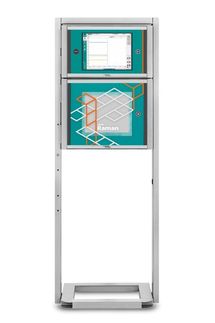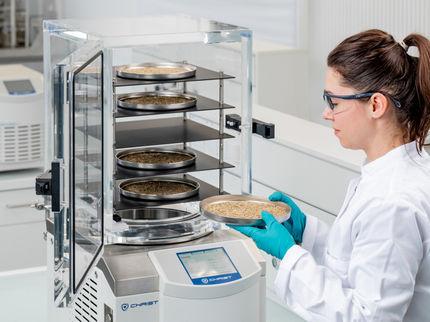Greater wing of sphenoid bone
| Bone: Greater wing of sphenoid bone
|
|
|
| Figure 1: Sphenoid bone, upper surface.
|
|
|
| Figure 2: Sphenoid bone, anterior and inferior surfaces.
|
| Latin
| ala major ossis sphenoidalis
|
| Gray's
| subject #35 149
|
| Dorlands/Elsevier
| a_21/12118035
|
The greater wing of the sphenoid bone, or ali-sphenoid, is a bony process of the sphenoid bone; there is one on each side, extending from the side of the body of the sphenoid and curving upward, laterally, and backwards.
Structure
The greater wings of the sphenoid are two strong processes of bone, which arise from the sides of the body, and are curved upward, lateralward, and backward; the posterior part of each projects as a triangular process which fits into the angle between the squamous and the petrous part of the temporal bone and presents at its apex a downwardly directed process, the spine of sphenoid bone.
Cerebral surface
The superior or cerebral surface of each greater wing [Fig. 1] forms part of the middle cranial fossa; it is deeply concave, and presents depressions for the convolutions of the temporal lobe of the brain. It has a number of foramina (holes) in it:
- The foramen rotundum is a circular aperture at its anterior and medial part; it transmits the maxillary nerve.
- The foramen ovale is behind and lateral to this; it transmits the mandibular nerve, the accessory meningeal artery, and sometimes the lesser petrosal nerve.
- The sphenoidal emissary foramen is occasionally present; it is a small aperture medial to the foramen ovale, opposite the root of the pterygoid process; it opens below near the scaphoid fossa, and transmits a small vein from the cavernous sinus.
- The foramen spinosum, in the posterior angle near to and in front of the spine; it is a short canal which transmits the middle meningeal vessels and a recurrent branch from the mandibular nerve.
Lateral surface
The lateral surface [Fig. 2] is convex, and divided by a transverse ridge, the infratemporal crest, into two portions.
- The superior temporal surface, convex from above downward, concave from before backward, forms a part of the temporal fossa, and gives attachment to the temporalis;
- the inferior infratemporal surface, smaller in size and concave, enters into the formation of the infratemporal fossa, and, together with the infratemporal crest, serves as an attachment to the lateral pterygoid muscle.
It is pierced by the foramen ovale and foramen spinosum, and at its posterior part is the sphenoidal spine, which is frequently grooved on its medial surface for the chorda tympani nerve.
To the sphenoidal spine are attached the sphenomandibular ligament and the tensor veli palatini muscle.
Medial to the anterior extremity of the infratemporal crest is a triangular process which serves to increase the attachment of the lateral pterygoid muscle; extending downward and medialward from this process on to the front part of the lateral pterygoid plate is a ridge which forms the anterior limit of the infratemporal surface, and, in the articulated skull, the posterior boundary of the pterygomaxillary fissure.
Orbital surface
The orbital surface of the great wing [Fig. 2], smooth, and quadrilateral in shape, is directed forward and medially and forms the posterior part of the lateral wall of the orbit.
- Its upper serrated edge articulates with the orbital plate of the frontal bone.
- Its inferior rounded border forms the postero-lateral boundary of the inferior orbital fissure.
- Its medial sharp margin forms the lower boundary of the superior orbital fissure and has projecting from about its center a little tubercle which gives attachment to the inferior head of the lateral rectus muscle; at the upper part of this margin is a notch for the transmission of a recurrent branch of the lacrimal artery.
- Its lateral margin is serrated and articulates with the zygomatic bone.
- Below the medial end of the superior orbital fissure is a grooved surface, which forms the posterior wall of the pterygopalatine fossa, and is pierced by the foramen rotundum.
Margin
Commencing from behind [Fig. 2], that portion of the circumference of the great wing which extends from the body to the spine is irregular.
- Its medial half forms the anterior boundary of the foramen lacerum, and presents the posterior aperture of the pterygoid canal for the passage of the corresponding nerve and artery.
- Its lateral half articulates, by means of a synchondrosis, with the petrous portion of the temporal, and between the two bones on the under surface of the skull, is a furrow, the sulcus of the auditory tube, for the lodgement of the cartilaginous part of the auditory tube.
In front of the spine the circumference presents a concave, serrated edge, bevelled at the expense of the inner table below, and of the outer table above, for articulation with the squamous part of the temporal bone.
At the tip of the great wing is a triangular portion, bevelled at the expense of the internal surface, for articulation with the sphenoidal angle of the parietal bone; this region is named the pterion.
Medial to this is a triangular, serrated surface, for articulation with the frontal bone; this surface is continuous medially with the sharp edge that forms the lower boundary of the superior orbital fissure, and laterally with the serrated margin for articulation with the zygomatic bone.
Additional images
This article was originally based on an entry from a public domain edition of Gray's Anatomy. As such, some of the information contained herein may be outdated. Please edit the article if this is the case, and feel free to remove this notice when it is no longer relevant.
| Bones of head and neck: the cranium |
|---|
| Occipital | Foramen magnum - Squama occipitalis (Inion - Nuchal lines - Planum occipitale - Planum nuchale - Cruciform eminence - Internal occipital protuberance - Sagittal sulcus - Internal occipital crest)
Lateral parts (Occipital condyle - Hypoglossal canal - Condyloid fossa - Condylar canal - Jugular process - Jugular tubercle) - Basilar part (Pharyngeal tubercle) |
|---|
| Parietal | Parietal eminence - Temporal line - Parietal foramen |
|---|
| Frontal | Squama frontalis (Frontal suture - Frontal eminence - Superciliary arches - Glabella - Supraorbital foramen - Zygomatic process - Sagittal sulcus - Frontal crest - Foramen cecum) - Pars orbitalis (Ethmoidal notch - Lacrimal fossa - Trochlear fovea - Posterior ethmoidal foramen - Anterior ethmoidal foramen - Frontal sinus - Frontonasal duct) |
|---|
| Temporal | Squama temporalis (Articular tubercle - Suprameatal triangle - Mandibular fossa - Petrotympanic fissure) - Mastoid portion (Mastoid foramen - Mastoid process - Mastoid notch - Occipital groove - Sigmoid sulcus - Mastoid antrum) - Petrous portion (Facial canal - Hiatus of the facial canal - Internal auditory meatus - Subarcuate fossa - Carotid canal - Aqueduct of cochlea - Jugular fossa - Inferior tympanic canaliculus - Mastoid canaliculus - Styloid process - Stylomastoid foramen - Petrosquamous suture) - Tympanic part (Suprameatal spine) - Zygomatic process |
|---|
| Sphenoid | Body Superior surface (Ethmoidal spine, Chiasmatic groove, Optic foramen, Sella turcica, Fossa hypophyseos, Middle clinoid process, Dorsum sellae, Posterior clinoid processes, Petrosal process, Clivus) - Lateral surface (Carotid groove - Sphenoidal lingula) - Anterior surface (Sphenoidal sinuses) - Great wings (Spine, Foramen rotundum, Foramen ovale, Foramen Vesalii, Foramen spinosum, Infratemporal crest, Sulcus tubae auditivae) - Small wings (Superior orbital fissure, Anterior clinoid process, Optic foramen) - Pterygoid processes (Pterygoid fossa, Scaphoid fossa, Lateral pterygoid plate, Medial pterygoid plate, Pterygoid canal, Pterygoid hamulus) - Sphenoidal conchae |
|---|
| Ethmoid | Cribriform plate (Crista galli) - Perpendicular plate - Labyrinth (Ethmoid sinus) - Lateral surface Lamina papyracea - Uncinate process - Medial surface Middle nasal concha - Superior meatus - Superior nasal concha - Middle meatus |
|---|
|







